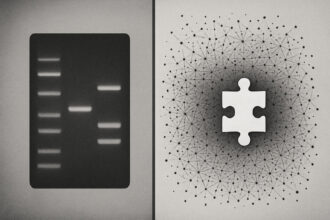A new study from Aarhus University promises to transform the way forensic investigators analyze fingerprintsFingerprint, impression made by the papillary ridges on the ends of the fingers and thumbs. Fingerprints afford an infallible means of personal identification, because the ridge arrangement on every finger of every human being is Read Full Definition. This is especially true in cases where traditional methods fall short. The innovative research presents a method that enhances the ability to extract crucial information from weak and overlapping fingerprints. This is achieved by using chemical imaging. It offers the potential to significantly improve criminal investigations.
The Challenge of Overlapping and Weak Fingerprints
Overlapping and faint fingerprints often present major obstacles in forensic investigations. Conventional methods are limited in their ability to distinguish overlapping prints. They also struggle to detect very faint ones. As a result, many potentially valuable fingerprints are discarded, which can hinder the progress of criminal investigations.
In many countries, including Denmark, law enforcement agencies use gelatin lifters to collect fingerprints from crime scenes. These lifters are preferred for delicate surfaces like wall paint or uneven objects such as door handles. Once fingerprints are collected on the lifters, they are photographed for database comparison. However, photographing does not solve the issue of overlapping prints or faint evidence Evidence is any form of proof, such as objects, materials, or scientific findings, presented to establish or disprove a fact in a legal proceeding. It is used to reconstruct events and link or exclude individuals Read Full Definition, leaving investigators with limited options.
Evidence is any form of proof, such as objects, materials, or scientific findings, presented to establish or disprove a fact in a legal proceeding. It is used to reconstruct events and link or exclude individuals Read Full Definition, leaving investigators with limited options.
A Groundbreaking Method: Chemical Imaging Using DESI-MS
Researchers from the Department of Forensic Medicine at Aarhus University have developed a new method that could significantly improve the analysis of fingerprints collected on gelatin lifters. The technique, known as Desorption Electrospray Ionization Mass Spectrometry (DESI-MS), allows for the chemical imaging of fingerprints. It measures the chemical compounds in the prints based on their mass.
In DESI-MS, a fine spray of electrically charged solvent droplets is used to release and ionize substances from the surface of the fingerprint. These substances are then drawn into a mass spectrometer, where their mass is analyzed. This approach enables the identification of various chemical compounds present in the fingerprint, including skin lipids, amino acidsAmino acids are essential for protein synthesis. There are about 20, with ten being essential, not produced by the human body. Read Full Definition, and even external substances like nicotine or explosives.
DESI-MS was originally developed for general surface analysis two decades ago. This study marks the first time it has been successfully used to analyze fingerprints on gelatin lifters. This is a breakthrough that could enhance how police analyze and interpret fingerprints.

Practical Application in Criminal Investigations
The research, published in the journal Analytical Chemistry, holds great promise for practical applications. The technique offers a way to visually and chemically analyze fingerprints that were previously unreadable due to overlapping patterns or weak impressions. Researchers believe the method could be integrated into police workflows. It would be useful, especially in more serious criminal cases such as murder and rape.
Currently, the method is being tested on fingerprints collected from crime scenes by the Danish National Special Crime Unit. Preliminary results are promising, and forensic experts are optimistic that DESI-MS could be a game-changer in the field of fingerprint analysis.
The Potential for Personal Profiling
Beyond enhancing fingerprint visibility, the DESI-MS method has the potential to provide a wealth of personal information based on the chemical composition of the print. Fingerprints contain natural skin compounds such as lipids and amino acids. They also include environmental substances the individual may have come into contact with. This includes cosmetics, drugs, or even trace chemicals from explosives.
This opens the door to the possibility of using fingerprints for personal profiling. Researchers are investigating whether chemical signatures in fingerprints can be used to determine gender. They are also studying if these chemical signatures can indicate age. They are also looking at lifestyle habits (like smoking or drug use). Additionally, they are examining dietary habits. Fingerprints may also reveal contact with substances of abuse, such as cocaine or cannabis, further aiding criminal investigations.
Looking to the Future: Challenges and Opportunities
While the DESI-MS method shows immense potential, there are challenges to overcome. The scanning process is time-consuming. It may not be suitable for routine fingerprint analysis. Instead, it could be reserved for critical cases. In the future, the method could be used alongside traditional fingerprint analysis techniques. This would provide a more comprehensive understanding of the evidence.
The research team at Aarhus University is continuing to refine the process. They are working in collaboration with Danish police. They are also exploring its applications in real-world criminal cases. As they work to maximize the information that can be extracted from fingerprints, the method could become an essential tool in the forensic toolbox. It will help investigators gain more insights from this ubiquitous form of evidence.
Conclusion: A Leap Forward in Fingerprint Analysis
The new DESI-MS fingerprint analysis method represents a significant leap forward in forensic science Discover the fascinating field of Forensic Science, the application of scientific principles to legal matters. This post delves into its many disciplines, from DNA analysis to crime scene investigation, its importance in the justice system, Read Full Definition. This method enhances the ability to visualize overlapping and faint fingerprints. It offers the potential for personal profiling based on chemical analysis. This method could revolutionize how forensic investigators use fingerprints to solve crimes. While challenges remain, the potential applications of DESI-MS are vast. The method could soon play a pivotal role in high-profile criminal investigations.
Discover the fascinating field of Forensic Science, the application of scientific principles to legal matters. This post delves into its many disciplines, from DNA analysis to crime scene investigation, its importance in the justice system, Read Full Definition. This method enhances the ability to visualize overlapping and faint fingerprints. It offers the potential for personal profiling based on chemical analysis. This method could revolutionize how forensic investigators use fingerprints to solve crimes. While challenges remain, the potential applications of DESI-MS are vast. The method could soon play a pivotal role in high-profile criminal investigations.
Study Reference: Kim Frisch, Kirstine L. Nielsen, Jo̷rgen B. Hasselstro̷m, Rikke Fink, Stine V. Rasmussen, Mogens Johannsen. Desorption Electrospray Ionization Mass Spectrometry Imaging of Powder-Treated Fingermarks on Forensic Gelatin Lifters and its Application for Separating Overlapping Fingermarks. Analytical Chemistry, 2024; DOI: 10.1021/acs.analchem.4c02305











